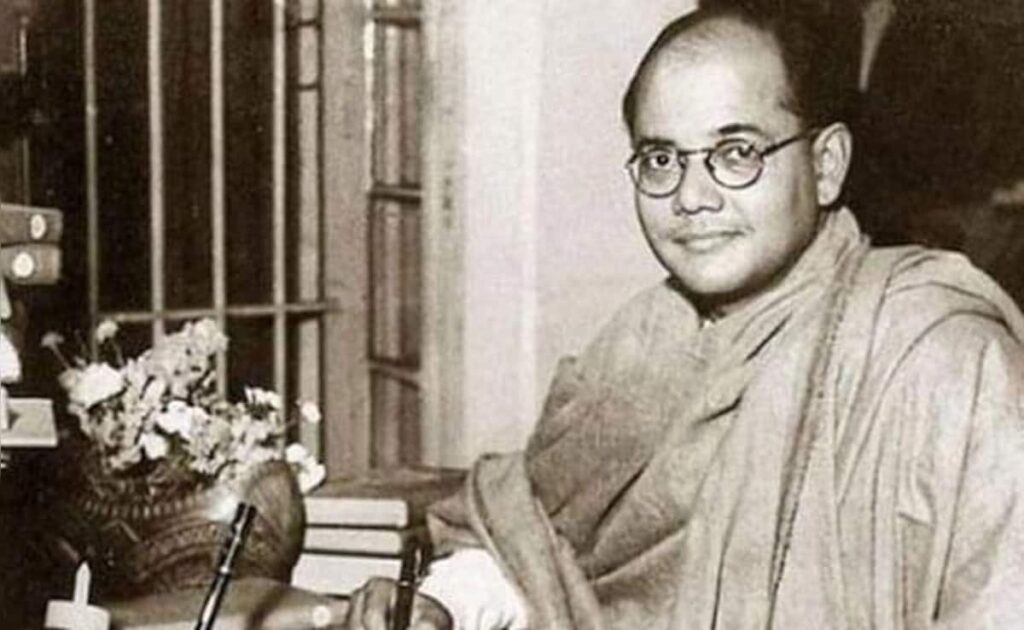Subhash Chandra Bose, or Netaji (“Respected Leader”) as he is often called, is a towering figure in Indian history. A brilliant leader, captivating speaker, and unwavering nationalist, Bose’s legacy remains complex and contested.

Subhash Chandra Bose’s Early Life and Education
Born in 1897 in Cuttack, Odisha, Bose came from a well-to-do Bengali family. Excelling in academics, he secured a coveted spot at the University of Cambridge to prepare for the Indian Civil Service. However, his nationalistic fervor grew, and upon witnessing the Rowlatt Act protests in India, he famously resigned from the service, choosing the path of freedom struggle over colonial comfort.
Subhash Chandra Bose : Rising Star in the Indian National Congress
Bose joined the Indian National Congress (INC), quickly rising through the ranks. He advocated for a more militant approach to independence compared to Mahatma Gandhi’s non-violent methods. He became President of the INC twice, in 1938 and 1939, but resigned due to ideological differences.

Azad Hind Fauj: A Daring Gamble
During World War II, Bose saw an opportunity to strike against British rule with foreign aid. He escaped house arrest in India and made his way to Germany and later Japan. With Japanese support, he formed the Azad Hind Fauj (“Indian National Army”), an armed force to fight for India’s liberation. The iconic slogan “Jai Hind” (Victory to India) became their rallying cry.
Legacy: Hero or Villain?
Bose’s wartime alliances with Nazi Germany and Imperial Japan continue to spark debate. While many admire his unwavering commitment to independence and his charisma as a leader, others criticize his association with fascist regimes and the violence employed by the Azad Hind Fauj. The mystery surrounding his death in 1945 further adds to the controversy.
Subhash Chandra Bose’s enduring significance lies in:
- His unwavering dedication to India’s freedom.
- His role in inspiring a generation of Indians to fight for self-rule.
- The powerful message of “Jai Hind” that continues to resonate.

However, his legacy is also marked by:
- His alliance with Axis powers during a horrific war.
- The violence employed by the Azad Hind Fauj.
Bose’s story remains a reminder of the complexities of India’s struggle for independence. He was a flawed hero, a man driven by a singular purpose – to see India free. Understanding his life and choices allows for a richer appreciation of India’s path to freedom.
Delving Deeper: Subhash Chandra Bose’s Complexities
The blog post provides a good foundation for understanding Subhash Chandra Bose’s life and legacy. Here’s some additional information to delve deeper:
Ideological Differences with Gandhi:
- Bose believed in a multi-pronged approach to freedom struggle, including industrialization and military action, which Gandhi opposed.
- Bose advocated for socialist economic policies, whereas Gandhi favored self-reliance and rural development.
Azad Hind Fauj: Achievements and Controversies:
- The Azad Hind Fauj garnered significant support from Indians living in Southeast Asia, particularly those who felt neglected by the British Raj.
- Their military campaign against the British in Burma (Myanmar) challenged British authority and boosted Indian morale.
- However, the alliance with Japan raised concerns about Bose’s methods and potential compromises.
The Mystery of Bose’s Death:
- The official story claims Bose died in a plane crash in Taiwan in 1945. However, many Indians believe he survived and went into hiding.
- This unresolved mystery continues to fuel speculation and conspiracy theories.
Exploring Further:
- Visit the National Museum in Delhi or the Netaji Subhas Chandra Bose Memorial Museum in Kolkata to learn more about Bose’s life and contributions.
- Read biographies by Sisir Kumar Mitra or Leonard A. Gordon for a deeper understanding of Bose’s ideology and wartime activities.
- Watch documentaries or films like “Netaji” (2016) to gain a visual perspective on his story.




